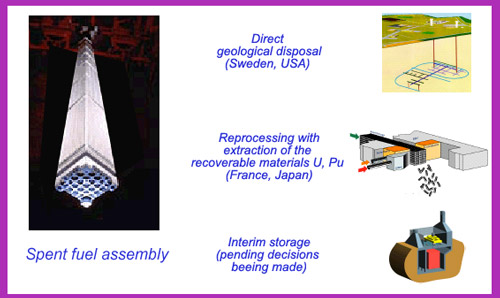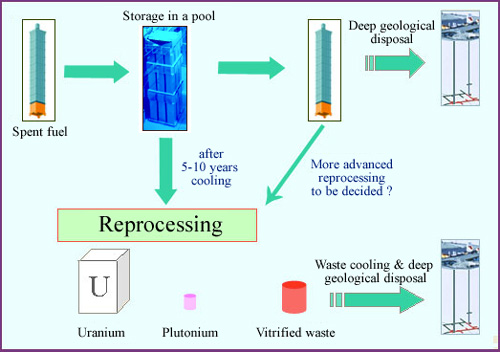Radioactive waste – not like any other kind of waste
Radioactive waste is not like normal waste. It cannot be treated like ordinary waste because of its radioactivity. Some of the highly radioactive waste coming out of reactors still has a very high energy content and under certain conditions could be used to make nuclear weapons.

What are the options for spent fuel?
Spent fuel from reactors is the main source of waste. The first option is to bury this spent fuel in deep geological strata; the second is to separate out the uranium and plutonium from the fuel (because of their energy potential) and bury as waste only what is left. The fuel can also be stored to let it cool down. This third option means that what to do with it can be put off to a later date, waiting a decision about geological disposal facilities.
© CEA
Two types of radioactive material are formed while the fuel is in the reactor. The first is medium mass nuclei, fission products , fragments of the nucleus that was split, and ash from the energy-producing reaction. These fragments are considered to be radioactive waste. The second type of radioactive material consists of heavy nuclei produced by neutron capture that has not led to fission, minor actinides
, fragments of the nucleus that was split, and ash from the energy-producing reaction. These fragments are considered to be radioactive waste. The second type of radioactive material consists of heavy nuclei produced by neutron capture that has not led to fission, minor actinides and plutonium
and plutonium .
.
The bulk of the uranium – 95% – comes out of the reactor intact. It makes a very small contribution to the radioactivity. It should not be seen as waste because it can still produce energy.Plutonium accounts for 1% of the mass. Because of its composition, the plutonium from civil reactors is not suitable for making nuclear weapons, but it still has a very high energy content. Major nuclear nations such as France and Japan have chosen to take advantage of this valuable material.
The US, which relies heavily on oil for its energy needs, has taken little interest in civil plutonium. As for weapons-grade plutonium, the country’s specialist military reactors produced more than enough during the Cold War. The US therefore decided to treat plutonium as waste and leave it in the spent fuel.
This attitude has recently changed with the prospect of the more economical and less wasteful reactors that would be available by around 2040. All or almost all of them involve the recovery of the constituents of spent fuel and go beyond the possibilities offered by industrial reprocessing today, which merely separates out the uranium and plutonium.
Currently at the La Hague plant in France, the most highly radioactive waste is vitrified. In this form, the radioactivity is trapped for a long time. The inalterability of the glass gives a good level of assurance that the radioactivity will not be dispersed.

What becomes of spent fuel?
This diagram shows the route taken by irradiated fuel assemblies depending on whether or not they are reprocessed. At the top (the non-reprocessing option), no better solution has yet been found than a storage in a pool for a first stage, pending a decision about a final disposal or reprocessing at a later stage. In the case of reprocessing, the uranium and plutonium (destined for recycling) are separated from a highly radioactive residue. This residue, the final waste, is vitrified for disposal but decisions about the disposal are also yet to be made.
© IN2P3
Radioactivity can take time to disappear…
Radioactive waste is not like ordinary waste because of the periods of time to be taken into account. Radioactivity decays according to natural laws, but only slowly. The activity of most waste is almost entirely gone after 300 years. We are here on Earth only fleetingly. Three centuries is the amount of time that has passed since the reign of Louis XIV, but it is also ten generations of engineers and sixty presidential elections.
Vast scientific and technological progress will be made over three centuries, but many other events could perturb society in the meantime. France was invaded five times between 1814 and 1945. The vicissitudes of history are not necessarily consigned to the distant past(*) . Inalterable matrices and burial sites out of reach are a safeguard against these vicissitudes.
. Inalterable matrices and burial sites out of reach are a safeguard against these vicissitudes.
See for example ANDRA’s timeline.
Articles on the subject « The waste issue »
Waste or resource?
Spent fuel can still generate a lot of energy The fuel removed from a reactor core after three or[...]
Fuel Reprocessing
The spent fuel reprocessing option Spent fuel reprocessing is derived from a process called the P[...]
Alternative to reprocessing
Leave fuel as it is : do not reprocess If the spent fuel does not undergo reprocessing, the fuel [...]
What to do with plutonium
A highly strategic material and a hazardous type of waste What becomes of plutonium is central to[...]
Plutonium options
Plutonium: hazardous waste or miraculous raw material? For those who advocate pulling out of nucl[...]
Costs comparison
Reprocessing or not reprocessing: a comparison Which option for dealing with spent fuel from reac[...]